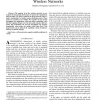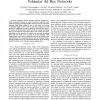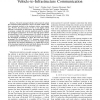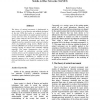430 search results - page 5 / 86 » Modeling mobility for vehicular ad-hoc networks |
TON
2002
13 years 7 months ago
2002
Abstract--The capacity of ad hoc wireless networks is constrained by the mutual interference of concurrent transmissions between nodes. We study a model of an ad hoc network where ...
INFOCOM
2007
IEEE
14 years 1 months ago
2007
IEEE
Abstract— Vehicular Ad Hoc Wireless Network (VANET) exhibits a bipolar behavior in terms of network topology: fully connected topology with high traffic volume or sparsely conne...
WCNC
2010
IEEE
13 years 11 months ago
2010
IEEE
—The newly emerged vehicular ad hoc network adopts the contention based IEEE 802.11 DCF as its MAC. While it has been extensively studied in the stationary indoor environment (e....
INFOCOM
2010
IEEE
13 years 6 months ago
2010
IEEE
—Inter-contact time between moving vehicles is one of the key metrics in vehicular ad hoc networks (VANETs) and central to forwarding algorithms and the end-to-end delay. Due to ...
CNSR
2007
IEEE
14 years 2 months ago
2007
IEEE
The theory of natural movement is fundamental to space syntax: a set of theories and methods developed in the late 1970s that seeks, at a general level, to reveal the mutual effec...




